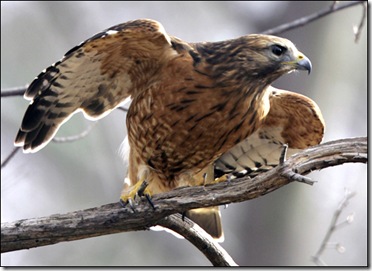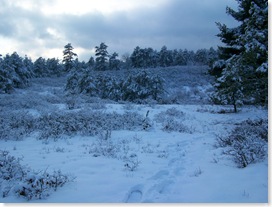Wednesday, January 28, 2009
Rescued Baby Red-Tailed Hawk
This past weekend, my girlfriend's dad found a young Red-Tail Hawk in his backyard. The bird seemed cold & weak, perhaps even dying, while Zoe the pug barked & danced around in front of the raptor. So, Art put on a pair of leather gloves and, without any resistance from the young hawk, picked it up and brought it inside the house, down in the basement.
He phoned one of his daughters, Joy, a knowledgeable lover of animals, and she came over to care for the bird for a couple of days. On Monday, she brought the hawk to the local animal rescue league. No doubt her diligent & patient care of the animal over the weekend saved its life.
On Sunday, I was able to see the bird up close, even had the opportunity to touch his feathers & massage the back if his neck. I don't know if it was male or female, but we all referred to the bird as a male. Joy had mixed some water with chicken livers and, using a small syringe, patiently fed & cared for the hawk. She told me that the bird's color was much better than the day before, soon after he was taken from the cold.
No one seems to know exactly where the hawk came from, or how he ended up in Art's back yard. There are no trees in the yard itself, so apparently he wandered onto the property from a nearby yard. He wasn't moving very much when he was found, so it's unknown whether or not he can fly. He could've been hurt somehow or perhaps became hypothermic in the cold weather.
Hawks are prolific hunters, feeding mostly on rodents, snakes & lizards. They can live over 20 years in the wild and have no natural predators. Diminishing habitat & pollution have become its fiercest enemies over time, placing humans as its only real predator. Females are typically 1/3 larger than the males.
One thing that was so striking when I was up close observing this amazing creature was how alert he seemed to be. No movement went undetected, and when he looked at you, it was almost as if he was looking through you. A hawk's eyesight is 8 times more powerful than a human's, able to zoom in on a squirrel or even a beetle from an incredible distance.
To have seen & touched the young hawk was a really cool experience. I hope & trust that he'll recover fully & be out soaring the skies soon. For more info on Red-Tails, check out these links below: http://animals.nationalgeographic.com/animals/birds/red-tailed-hawk.html
http://www.desertusa.com/aug96/du_hawk.html
http://www.wildlifesearch.com/hawk.htm .
~The Pilgrim.
Posted by
The Pilgrim
at
12:21 PM
0
comments
![]()
Labels: red-tail hawk, wildlife
Wednesday, January 21, 2009
Mt. Greylock State Reservation
 On Friday, Oct. 17th, 2008 I headed up to Lanesborough, MA to hike around in the Mt. Greylock State Reservation area. The AT runs through this reservation and over the summit of Mt. Greylock, the highest point in Massachusetts at 3491 feet. I wanted to get some miles in on The Trail, and had invited a friend of mine to come along. Well, I wound up going alone. Click here for more info on Mt. Greylock Reservation.
On Friday, Oct. 17th, 2008 I headed up to Lanesborough, MA to hike around in the Mt. Greylock State Reservation area. The AT runs through this reservation and over the summit of Mt. Greylock, the highest point in Massachusetts at 3491 feet. I wanted to get some miles in on The Trail, and had invited a friend of mine to come along. Well, I wound up going alone. Click here for more info on Mt. Greylock Reservation.
The drive from Plymouth to Lanesborough was about 2 hrs, 15 mins. I got a bit of a late start, due to some last minute errands I needed to run. When I arrived at the Visitor's Center at about 4 pm, I spoke with one of the rangers up there about the reservation and the AT. He told me the closest shelter to the VC was the Mark Noepel shelter, 6 miles away. So, that's where I headed. It was getting late, just about 4:40 pm when I finally hit the trail.
From the VC I headed north, taking the Northrup Trail to Jones Nose, which then intersects the AT just below Saddle Ball Mountain. From that point, I turned southeast on the AT for less than a mile before I reached the shelter. It started getting dark a little after 6 pm, which didn't worry me, as I did bring my headlamp for such occasions. Around 6:40, I finally decided to pull out the headlamp. Now, I did test all my equipment, especially the headlamp back at home before leaving to come up here. But, wouldn't ya know it, when I took it out and pressed the button, nothing happened. Luckily for me, I had a small photon light in my pocket. That little thing got me through the darkness and to the shelter.
Once at the shelter, I looked around, found some old batteries. After a couple minutes, I was able to get my headlamp working. That was a relief! Seeing now was much better than with the photon light I was using. There was a bunch of branches and limbs gathered near the firepit by previous hikers or rangers, and a saw inside the shelter for cutting up the thicker stuff. So I built a fire, which took a while to get burning well with the wind that was kicking up. Inside the shelter, I changed into some warmer clothes and even set up my tent. I figured since I was the only one there, the wind beginning to blow, I may be a bit warmer this way.
The old faithful shelter register was in a box on a wall inside the shelter. I thumbed through it, recognized several names on its pages. It took me back in my mind not too many months ago, and I envisioned myself writing an entry. I was tired & hungry, but skipped dinner to get inside my bag and sleep. It wasn't a good night's sleep, as several animals were heard around the shelter. Something, a bobcat I suspect, was beneath the shelter, growling at something else. I don't know how cold it got that night, but it felt about 20 degrees.
In the morning, as usual, I tossed & turned in my bag, delaying the inevitable. But this time, I was really hungry, having skipped dinner the night before. So, I cooked up some Ramen noodles & a tuna packet, had 2 cups of coffee, and I was ready for the privy! It was about 9:30 when I eventually hit the trail. Greylock summit was a little over 3 miles from the shelter, and my goal was to reach it by noon, so I was in no real hurry to get going. Besides, out here all you have is time, and I was enjoying every minute on the trail. On the way to the summit, I took lots of pictures. Unfortunately, as I write this entry, I don't seem to have them all saved in my computer. I'm not quite sure what happened to most of them. There was one of a tree with some claw markings from a black bear. That was pretty cool, but now it's gone I guess.
On the way to the summit, I took lots of pictures. Unfortunately, as I write this entry, I don't seem to have them all saved in my computer. I'm not quite sure what happened to most of them. There was one of a tree with some claw markings from a black bear. That was pretty cool, but now it's gone I guess.
When I reached the summit, it was just about 11:30 am, bright & sunny. There were a few other hikers, some runners that passed me on their way down the mountain. I drank some water & had a snack. My water was getting low, and I was contemplating how much further I'd go. The original plan was to hike all day and camp overnight again, then get up Sunday morning and head back to the VC. But that was if my friend Bob came along with me, which he didn't. So I decided that I'd hike back to the VC, another 8 miles away. I spoke with another hiker who was out doing a small section of the AT this weekend. He also was hiking alone, as a friend of his stuck him, too. I walked around the Massachusetts Veterans War Memorial, read the inscriptions on its impressive structure. The view behind the Memorial is fantastic, stretching into New Hampshire's White Mountains. Some of the pics I took from this spot are seemingly lost.
I drank some water & had a snack. My water was getting low, and I was contemplating how much further I'd go. The original plan was to hike all day and camp overnight again, then get up Sunday morning and head back to the VC. But that was if my friend Bob came along with me, which he didn't. So I decided that I'd hike back to the VC, another 8 miles away. I spoke with another hiker who was out doing a small section of the AT this weekend. He also was hiking alone, as a friend of his stuck him, too. I walked around the Massachusetts Veterans War Memorial, read the inscriptions on its impressive structure. The view behind the Memorial is fantastic, stretching into New Hampshire's White Mountains. Some of the pics I took from this spot are seemingly lost.  Bascom Lodge is also nearby, and like the War Memorial, is open seasonally. Because the Scenic Byway was closed for construction, not re-opening till Spring of 2009, the summit was pretty desolate. Normally, the weekend brings scores of people up here. I wasn't aware of the construction going on in this area until a few days before I headed up here, and didn't even think of encountering any crowds on the summit. But it was enjoyable just to sit in the sun and relax for a bit before heading back down.
Bascom Lodge is also nearby, and like the War Memorial, is open seasonally. Because the Scenic Byway was closed for construction, not re-opening till Spring of 2009, the summit was pretty desolate. Normally, the weekend brings scores of people up here. I wasn't aware of the construction going on in this area until a few days before I headed up here, and didn't even think of encountering any crowds on the summit. But it was enjoyable just to sit in the sun and relax for a bit before heading back down. Those mountains in the distance are what every thru-hiker has travelled towards and climbed. I thought of all the fine people I met along the trail last spring, the happiness of their thru-hike, and what it is they're doing now. I look forward to seeing some of them again, and to meeting new people this coming spring.
Those mountains in the distance are what every thru-hiker has travelled towards and climbed. I thought of all the fine people I met along the trail last spring, the happiness of their thru-hike, and what it is they're doing now. I look forward to seeing some of them again, and to meeting new people this coming spring. This here is one last look before heading back down to the Visitor's Center. I reached the VC a little after 4 pm that day, hiking a total of 17.3 miles on my mini get-away. It was a needed time away alone, even if just for a day and a half. Anyone who loves to hike knows just what I'm talking about, especially that which can't seem to be put into words. "What do you do when you go hiking?" people ask me sometimes. "Well, I hike. I enjoy the scenery, take pictures, make memories, think deep thoughts," lol.
This here is one last look before heading back down to the Visitor's Center. I reached the VC a little after 4 pm that day, hiking a total of 17.3 miles on my mini get-away. It was a needed time away alone, even if just for a day and a half. Anyone who loves to hike knows just what I'm talking about, especially that which can't seem to be put into words. "What do you do when you go hiking?" people ask me sometimes. "Well, I hike. I enjoy the scenery, take pictures, make memories, think deep thoughts," lol.
~The Pilgrim.
Posted by
The Pilgrim
at
7:31 PM
0
comments
![]()
Labels: massachusetts hiking, mt greylock
Tuesday, January 20, 2009
Snowshoeing In Myles Standish State Forest
Today I went for a short 2-2.5 mile hike in the snow, or snowshoeing. If you've never done it, but enjoy hiking, then you really need to give snowshoeing a shot. Myles Standish State Forest in Carver, MA has a number of trails that are good for cross-country skiing & snowshoeing in the winter. We've had a good droppage of snow on the east coast in the past few weeks. Last year was pretty mild, and it seems like nature is making up for it.
After leaving the Jeep in a designated parking spot, I headed up into the woods following a snowmobile route. Wish I had come here a few days ago, after that last snowfall we had, as the trail wouldn't have been so packed from the machines. This is a road not open to vehicles.
 After about 15 minutes, I decided to go off road into the untouched white. When I re-entered the trail, I spotted some deer tracks here & there. In the distance was the scream of 2 snowmobiles several hundred yards behind me. That pretty much killed any chance of seeing some wildlife today. Other than that, it was pretty peaceful, save for the sounds of my snowshoes floating on the snow.
After about 15 minutes, I decided to go off road into the untouched white. When I re-entered the trail, I spotted some deer tracks here & there. In the distance was the scream of 2 snowmobiles several hundred yards behind me. That pretty much killed any chance of seeing some wildlife today. Other than that, it was pretty peaceful, save for the sounds of my snowshoes floating on the snow.
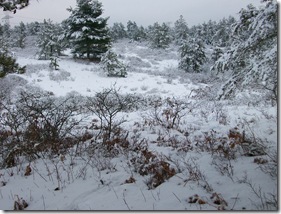 At one point, I followed along a route of power lines for about 20 minutes or so. There was the faint barking of a dog, sounded like a coon hound, then growing louder & louder. When I looked behind me, a truck was driving toward me. The man driving stopped and chatted for a minute. Said he was gonna let his dog loose in the woods, "see what he chases outta there."
At one point, I followed along a route of power lines for about 20 minutes or so. There was the faint barking of a dog, sounded like a coon hound, then growing louder & louder. When I looked behind me, a truck was driving toward me. The man driving stopped and chatted for a minute. Said he was gonna let his dog loose in the woods, "see what he chases outta there."
src="http://pagead2.googlesyndication.com/pagead/show_ads.js">
As far as what's needed for snowshoeing, other than your normal hiking/backpacking gear, is a pair of snowshoes & maybe some poles. The snowshoes should be rated for your own body weight and for the type of snow you'll be walking through. For some good tips on snowshoeing check out this site, www.backpacking.net/winter.html .
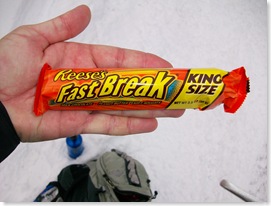 Remember to always bring some water when snowshoeing and, of course, a snack. I almost always have some sort of trail mix in my pack when I head into the woods, but today I was in the mood for something a bit sweeter.
Remember to always bring some water when snowshoeing and, of course, a snack. I almost always have some sort of trail mix in my pack when I head into the woods, but today I was in the mood for something a bit sweeter.
For the hardcore 3-season hiker, snowshoeing is a great way to help keep your muscles in shape for the hiking seasons. It's an excellent cardio workout and definitely more strenuous than normal hiking, especially when climbing hills. Check your local ski shops about renting some snowshoes before you go ahead and spend a lot of money. Top of the line shoes can cost you over $300, but for the average person, there's no reason to spend that much. The shoes I bought were a close-out sale, costing me less than $100. Whether you go alone or with a group of friends, it's a lot of fun. Check it out!
~The Pilgrim.
Posted by
The Pilgrim
at
3:39 PM
0
comments
![]()
Labels: snowshoeing
Wednesday, January 14, 2009
Crude Review On Vasque XCR Boots
Well, I guess this is the 1st Crude Review on Crude Analysiz. What's a Crude Review? Glad you asked. A Crude Review, other than a simple review I post here on Crude Analysiz, is an honest & objective review of a piece of gear used in the real world, usually by myself. This review is of the boots I wore on the AT for 470 miles. If you would like your own review of a piece of gear added to this blog, feel free to contact me about it. I'd love to hear & read your reviews!
On my 5 week sojourn of the AT, the boots I wore were the Vasque Breeze XCR with Gore-Tex. For myself, I don't expect the world from any gear that I buy, and typically tend to disregard the hype. This way, I'm not too let down if something doesn't quite work as well as I'd hoped.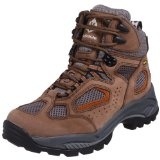
Vasque Breeze XCR GTX
The Vasque Breeze boots held up very well for me. My feet were comfortable, warm on cold days, didn't overheat on warmer days. I wore one pair of socks during the hike at all times. Some hikers prefer to wear two pairs, one as a liner, helping to prevent blisters or for just a bit more warmth. For dryness, my feet were dry when trudging through mud, crossing streams and on days when it rained lightly. The only time my feet were wet was during sustained heavy rains. In rains like those, I don't know any hiking boot that keeps out the wetness completely. When submerged in water, any hiking boot will eventually leak water to the inside.
I believe your boots are probably the most important piece of gear you have when hiking/backpacking. Obviously, walking is the mode of transportation, so your feet need the best possible protection when traversing rocks, hills, mountains, streams, etc. Lightweight but tough, that's how I'd classify the Vasque Breeze XCRs. And if you expect the boots you wear to take care of your feet, then you need to take care of the boots. There's an interesting article in Backpacker Magazine in caring for your boots. Dave Page, a Seattle-based cobbler, has some helpful tips here in helping your boots to last.
As to my own opinion, that which some may share or disagree with completely, is your boots will wear according to the way you walk. Whether a foot is pointed outwards or inwards, if you walk more on the blade of your foot or put more pressure on the instep, these have an effect on the way your boots wear over time. Not only will how you walk determine the way your boots wear, but also how your ankles and feet will fare over time. I believe a lot of misdirected blame is placed on the boots people are wearing, when in fact some of the pain they experience in their feet during hiking can be attributed to poor walking habits. But again, this is my opinion, as crude as it may be.
~The Pilgrim.
Posted by
The Pilgrim
at
5:24 PM
0
comments
![]()
Labels: AT, crude reviews, hiking boots
Thursday, January 8, 2009
Hiking Sharpens Senses
Yesterday it seemed that after 4+ weeks of wilderness sojourning, my senses were finally beginning to soften & open to the sights, sounds & smells of the glorious outdoors. At one point, it was almost as if I could reach out & stroke the mountains, run my fingers along the texture of the treetops, or smoothen the wrinkles in the seeming fabric of the landscape.
Our senses have become so dulled by the world and its petty obligations it imposes on us day after day. It takes time for our hearts & minds to shed the callouses that stifle our senses & blind our thoughts. It's that coming together of all senses which Rilke wrote about years ago~a sort of synergistic action where every sense is experiencing its own facet of a single action, thought or emotion. It's as though I've had to wait & see, hear, smell, touch & taste everything, learn to use all my senses again, yet in a different, more meaningful way. The schedules & pressures of life seem so small out here, so inconsequential. I see the attraction that long-distance hiking has for thousands, even millions of people. I can only pray that I don't lose this appreciation which is growing within me!
Posted by
The Pilgrim
at
9:40 PM
0
comments
![]()
